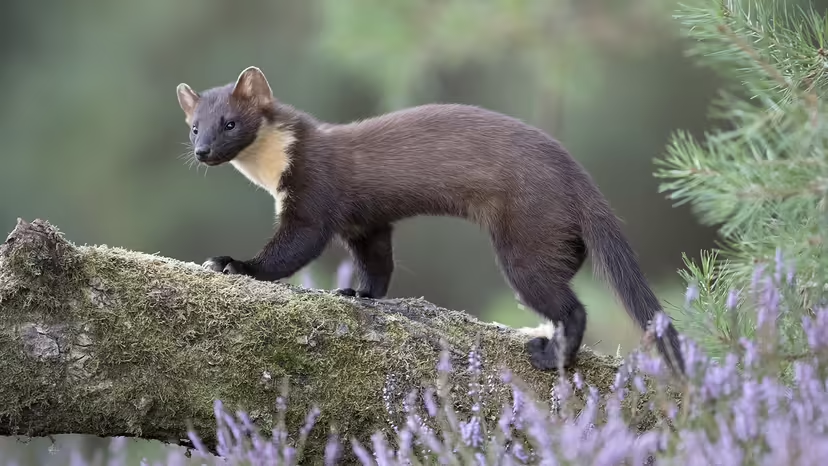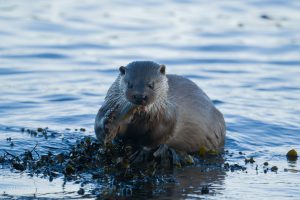SUPPLEMENTARY FEED
Just recently there has been lots of debate on supplementary feed and also a lot of pictures from our wonderful guests to the peninsula where the food may need a little tweaking, so I thought I would try and put something together to help. This is not intended to offend or criticise anyone, just be useful. It’s Pine Marten focused just so I’m not putting too much detail on other species! I’m currently writing up red squirrels, so can share that if there’s a call for it – while Pine Martens are well established here, Red Squirrel could use a little help spreading.
What does a Pine Marten’s diet naturally look like? There’s a fair bit of literature out there, so I’ve drawn on research from Fiona Caryl & team, Munoz-Garcia & Williams (2005), RJ Putman (2000) and Powell (1993) as my main sources. A really interesting part of Caryl’s research looks at seasonal differences, where a Marten can eat mainly fruit in Autumn compared to mainly meat in Summer. The majority of the reason for this is availability, but they will have evolved a need for a good degree of mixture in their diet. The general consensus globally with Pine Martens suggests 77% meat, 11% invertebrates and 11% veg (including fruit), though Caryl found an average of around 30% fruit in a Scottish Marten’s diet. If we compare, a badger will eat around 14% meat, 62% invertebrates and 24% vegetables. If we look at general diet, the sugars mainly occur in Autumn when the majority of the fruit is consumed, though I generally find the scat is full of Rowan berries and often blackberries, both of which are quite low sugar and lower energy than some fruits. Rowan berries for example contain around 15% carbohydrates, which is mainly natural sugars. Johnny Birks Pine Martens book has a useful summary on diet in it.
As food to feed, we need to ensure that we are mirroring natural diet as much as we can and always steering clear of things with refined sugar. Some great ideas are dry dog food (has similar nutrient levels to that which a pine marten needs), some fresh fruit (blackberries, Rowan berries in Autumn for example). Freshly killed thawed meat and occasionally eggs will be included in their normal diet. Peanuts are common, but that’s something we should be very careful with as they lack the calcium to keep bones healthy and Marten’s are susceptible to Metabolic Bone Disease – there are several studies that link diets high in peanuts with MBD. Good ways to help with this are deer antlers, almonds and sesame seeds.
A pine marten needs to consume an average of around 360 KJ per day (Basal Metabolic Rate is 362.3 KJ/d). To put that in context an otter is over 3000 KJ. That means if we take peanuts as an example, 15g of peanuts equates to the total calorific intake for the day. An egg is on average 310 KJ. Naturally body mass will create some wiggle room here, but as a species, they don’t need to consume vast amounts, so you don’t need to put much food out.
In Winter, Pine Martens will naturally forage even more for food, so hide the food at this time and make them forage for the food. They will smell it well enough to still come!
Mustelids are creatures of habit and tend to follow paths across generations. Peter Dale tells some fantastic stories about otters following the same routes before and after the Sullom Vow Oil and Gas terminal was built in Shetland, so if your property is on their route, they will continue to visit. Pine Martens will move about during the year based on the food that’s available, so may be naturally somewhere else in Winter compared to Summer and any supplementary feed needs to bear than in mind as you may be inadvertently keeping them near you when they need to be somewhere else to do the majority of their hunting or foraging. Don’t supplementary feed in the same location all the time, it’s important to move around so you don’t change the behaviour significantly.
If you are renting a cottage and feed every day, the next people probably will too, so be aware and maybe put the right food out once or twice. You’ve still got a good chance the Martens will be by, so just be patient.
Why is all this important? Firstly, behaviour. Because Martens are so habitual, if you feed them every day, they quickly become reliant on you and their routes and habits will change, young will learn to feed at the easy source instead of dispersing and the skills of foraging and hunting will diminish. Secondly, health. We are all here because we care about and love wildlife and if our well intentioned behaviour leads to their suffering, we need to do better. A diet rich in peanuts is known to carry a high risk of Metabolic Bone Disease for example. While a Pine Marten may love the refined sugars in Jam (or even peanut butter), it is desperately bad for their digestive systems and teeth – think chocolate and dogs. Anything containing refined sugar needs to be avoided.
I read one post that said that it’s fine to feed small birds, so why not pine martens? It also likened feeding garden birds to the reintroduction of White Tailed Eagles (sorry, not picking you out specifically, just an important distinction). Feeding a robin and the supplementary feed of a white tailed eagle on reintroduction are very different things. The same is true of small birds compared to a mustelid. It’s a really good point about garden birds as they often need help in urban environments where foraging and hunting can be challenging, but somewhere like this, they need help in the tough times when it’s hard to fly or prey/foraging is difficult. Under certain Winter (and sometimes Summer) conditions, wildlife does need our help and the right food can make a big difference. Where feeding wildlife presents a risk is when you modify the behaviour and feeding your garden birds every day all year does change that wild behaviour, it will also run the risk of introducing parasites and disease and can put the birds at risk (that doesn’t mean it will). If the conditions aren’t difficult, the supplementary feed is for our benefit largely. Wild animals will always choose the free meal, so supplementary feed every day does present a significant risk to animals and in particular mustelids as they are so habitual. By feeding them every day, especially with a mustelid, it will change their behaviour and make them reliant/dependent on the supplementary feed. Occasional is fine (especially in tough Winter conditions), but daily creates unnecessary risk.
I KNOW THAT WAS A LOT, SO A FEW EASY GUIDELINES.
1. Don’t feed every day. One or two days per week
2. Do not feed them refined sugar under any circumstances. Also, peanut butter has oils that can get into their fur and isn’t removed by just rainfall.
3. Change locations often (that means don’t feed in the same garden continually, this will change behaviour)
4. Give a mixture of food and think about the seasons when you do. Dog biscuits, deer antlers, almonds, sunflower seeds etc. all work well.


